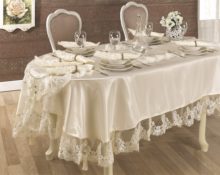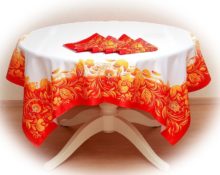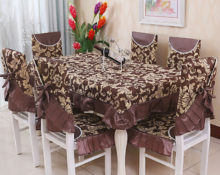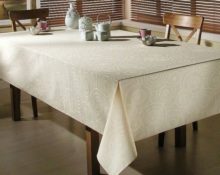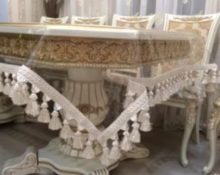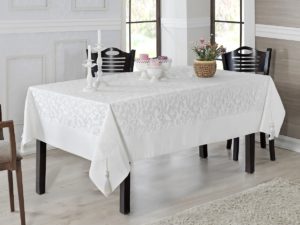 There is a popular belief that in order for there to be harmony, prosperity and well-being in the new family, the young wife must buy all the tablecloths herself. It is better not to accept textile products of this kind as a gift, since sometimes the person giving the gift may have malicious intent, which will certainly be followed by troubles and failures, which will be very difficult to get rid of.
There is a popular belief that in order for there to be harmony, prosperity and well-being in the new family, the young wife must buy all the tablecloths herself. It is better not to accept textile products of this kind as a gift, since sometimes the person giving the gift may have malicious intent, which will certainly be followed by troubles and failures, which will be very difficult to get rid of.
In order not to receive gifts of this kind, you need to tell everyone you know about what beautiful and successful tablecloths you can sew yourself. A useful skill will not only scare off ill-wishers, but will also allow you to save a decent amount of money, because table textiles quite often deteriorate due to difficult to remove stains and ready-made ones are much more expensive than the consumables for sewing them.
What you need to sew a tablecloth on a rectangular table
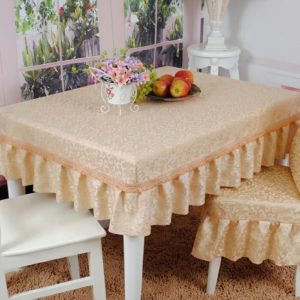
The first thing you need to do before starting to sew any product is to choose the appropriate material. Due to the fact that tablecloths, napkins and kitchen towels are in a constant risk zone (stains from food, drinks, dirty hands), increased demands are placed on the fabrics from which they are sewn, such as:
- density;
- crease resistance;
- ease of care;
- color fastness;
- environmental friendliness.
If the fabric combines all of the above qualities, dishes do not slip on it and also drapes well, it can be considered an ideal material for sewing. Most often preference is given to:
- cotton that absorbs moisture well;
- natural linen;
- “crane” produced in Belarus;
- blends of cotton and polyester;
- teflon materials.
A significant role when choosing a fabric is played by its color and the presence of a pattern. The most popular and versatile options for the kitchen are light colors, which look elegant and do not spoil the appetite.
Cool shades of blue, green or blue can slightly reduce your appetite, but at the same time calm your frayed nerves. Warm red, orange and brown tones excite the appetite and fit perfectly into a festive or homely atmosphere. Fabrics with patterns are more suitable for decorating children's birthday parties or outdoor picnics.
Having chosen a more successful option for yourself that combines all the necessary qualities, you need to stock up on other materials and accessories that will definitely come in handy when sewing a tablecloth for a rectangular table:
- threads;
- sewing machine;
- scissors with long blades;
- ruler and measuring tape;
- iron;
- thimble and other sewing accessories;
- items for decoration.
Important! It is not at all necessary to decorate a kitchen tablecloth, however, if table textiles will be used only on holidays and when receiving guests, fringe or a border around the edges will only decorate and complement its appearance.
How to sew a tablecloth on a rectangular table with your own hands
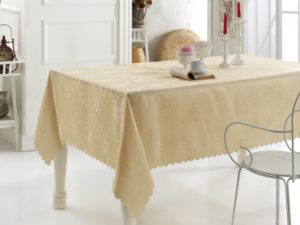
The process of self-tailoring can be divided into several stages:
- The first stage is calculating fabric consumption. To determine how much material will be needed, you need to measure the length and width of the rectangular tabletop and determine the length of the side overhangs. The length of the fabric is determined by adding the length of the table to the length of the overhang multiplied by two. To the resulting figure add 10 cm, which will go to the hem. The width is determined according to the same principle.
Important! Overhangs can be either long to the floor or slightly cover the side parts of the table (20-40cm). It should be remembered that the longer the edge, the more solemn the tablecloth looks, but the more inconvenient it is.
- The second stage is cutting the fabric. Pre-prepared patterns for sewing a tablecloth will not be needed. Marks are made on pre-ironed fabric with a pencil or a dried bar of soap. The excess is cut off.
Advice! Do not immediately throw away excess pieces of material. Perhaps they will be useful in the future for decorating finished textile products.
- The third stage is processing the corners. The tablecloth is considered the “business card” of every housewife. That is why it must have a presentable appearance on both the front and back sides. In order for the corners to be beautiful even from the wrong side, they need to be processed. To do this, the cut material is placed on the table with the wrong side up and folded 1 cm from each edge (the fabric is fixed with pins).The curls are thoroughly ironed (if the material allows it). Then, on both sides of the corners, pieces equal to two planned hem sizes are laid. The marks are connected to each other with a pencil. The fabric is folded inside out, lengthwise so that these points are connected, and the corner is stitched using a machine.
Important! To ensure that the corner turns out evenly, the edge of the remaining allowance at the fold is cut at an angle.
- The fourth stage is processing the hem. The sides are ironed and machine stitched from the wrong side at a distance of 1 mm from the fold.
Advice! If the tablecloth is made entirely by hand, without using a machine, the hem is sewn with a hidden seam.
Tablecloth decor options
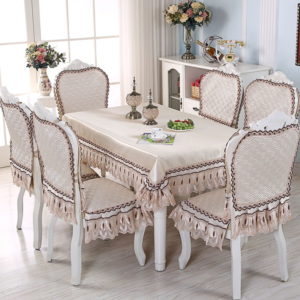
You can decorate a tablecloth for a rectangular table using:
- Embroidery Volumetric, smooth or textured cross-stitch embroidery can be placed along the edges of the tablecloth, in the middle or in the corner parts of the canvas.
- Other materials. You can achieve an interesting result by placing another, smaller piece of fabric of a different color on top of one tablecloth. Options with contrasting shades look the most successful.
- Openwork napkins. Beautiful openwork napkins laid on top of the tablecloth help diversify its look and add flirtatiousness to even the most boring table textiles.
When planning to sew a tablecloth with your own hands, it is important to remember that even the simplest and most ordinary-looking fabric, if it is matched to the main color scheme of the kitchen space, will become a real decoration of any interior. Even the most budget furniture is transformed with a long tablecloth decorated with embroidery or fringe.Curtains, tablecloths, napkins, towels and chair covers made from the same material look especially interesting within the same room. It is enough to study the photos with examples and sew the product yourself.


 0
0